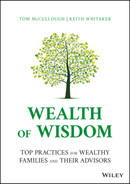SECTION 3
PLANNING THOUGHTFULLY
“Plans are nothing, but planning is everything,” holds a well-worn aphorism. It reflects the nature of reality: Things never turn out just as we expected. To quote a less-hopeful version, “Man plans, and God laughs.” Despite the divine laughter, going through the work of planning helps prepare the mind for whatever fortune throws its way.
Planning is an essential component of managing financial wealth. Typically, that planning takes place under the auspices of various experts: financial planners, estate planners, investment managers, business succession experts, and so on. As a result, many times families feel that their plans are something external to themselves, not something they truly live. Sticking to a plan, or keeping it up to date, can be a real challenge.
The chapters in this section aim to address this challenge by providing exercises and tools in various aspects of planning that readers can easily apply, and reapply, to their own situations.
The section begins with John A. Warnick's guidance on “Expressing Purpose in Your Trusts.” Families with significant wealth typically have a multitude of trust structures in which they hold their assets and transfer those assets to future generations. Far too rarely do they give any thought to the purpose of those structures, with often painful results for beneficiaries. Warnick's exercise gives trust creators a clear path for discerning their purposes and then incorporating those purposes into their trusts or their instructions for future trustees.
In the next chapter (reprinted from the first Wealth of Wisdom volume), Jamie Forbes describes steps to take to maintain shared ownership of a family vacation home. This is a topic that many families struggle with, given the great emotional power that a beloved family gathering place can have. Forbes uses the experience of his family's century-long stewardship of the island of Naushon, off Cape Cod, to offer practical guidance to any family seeking to preserve a home for generations.
Jay Hughes then turns our attention to the power of family financial assets to foster family members' abilities (especially in communication and entrepreneurship), through the mechanism of the “Family Bank.” Though it doesn't require a charter, a family bank works best when it combines attention to each family member's needs and skills along with some formality of decision-making, whether that is in making loans or giving grants to family members for projects such as buying a house, starting a business, pursuing additional education, or the like.
Risk is a key element of planning, and yet it can often feel hard to evaluate. Linda Bourn offers readers a way to assess themselves regarding “What keeps you up at night?” in a variety of areas: cyber-risk, natural disaster risk, private collectibles, personal security, and so on. Her assessment then points to specific actions to take, whether in the form of asset retitling or relocation, expert consultation, or insurance.
Every community requires infrastructure—families too. For a family with significant wealth, that infrastructure takes the forms of effective monitoring of assets, financial controls, expense and liquidity management, human resource management, and reputation management—to name only a few items. Natasha Pearl gives readers a mechanism to evaluate their “infrastructure” and its needs, to see where it is crumbling or nonexistent, and then to determine what steps are necessary to upgrade the system.
A common challenge for family members is to learn and keep track of all the operational details of managing significant family wealth. Due to specialization and confidentiality, many important documents and reports can easily become lost or siloed, making information very hard to deploy in an emergency. In the next chapter, based on his own family's experience, Josh Kanter instructs readers how to create a “Family Owners' Manual” that consolidates this crucial information in one place, with flexibility to add to or change the manual as time goes on.
Clearly, the most important assets in any family are the family members themselves, and the last four chapters in this section deal with planning as it regards their health, well-being, and values.
Arden O'Connor helps families take on the difficult task of assessing behavioral health challenges (e.g., around alcohol, drugs, or mental illness) as well as guidance of what to do in a behavioral health crisis.
Given that so many family members are living longer than past generations, Susan Hyatt then offers readers a “Smart Aging Audit.” Readers can think specifically about their medical information and needs, personal preferences and financial preparedness for the future, and end-of-life planning, by considering not only what they have in place now but “what if” different scenarios should come to pass.
Almost all families include members who suffer from diminished capacity as they age, a condition that can become even more challenging if the family member controls significant financial or business resources. Patricia Annino offers a list of steps to take before a family member's capacity diminishes, as well as guidance for opening up the conversation of diminished capacity with key family leaders.
Finally, planning often involves one's legacy—what one leaves behind. Most people consider their values to be a key part of their legacy, and yet they struggle with how to pass on those values. Scotty McLennan rounds out this section with a wonderful exercise—“Creating an Ethical Will”—that has stood the test of time and that gives parents or grandparents a way to express their most deeply held feelings and beliefs and to share those effectively with the people they love most.
